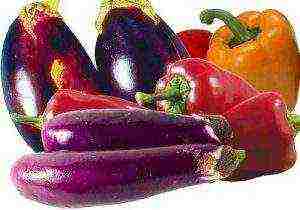Content [show]
Do you know about a plant like ornamental cabbage? If not, then we will introduce you to him and tell you how to grow this beauty. The very name "decorative" suggests that this cabbage is very picturesque. It is also good in that it does not lose its attractiveness even in late autumn, when all other plants wither and die off.
Ornamental cabbage looks great even on flower beds among other flowers, even in separate boxes or pots. By the way, it can be grown not only for garden decoration, but also for eating. In appearance, cabbage comes in a variety of colors and leaf shapes. It is the leaves collected in unusual rosettes that are the decorative element of the plant. Cabbage is very light-requiring, but it can grow in partial shade. The only thing is that due to lack of sun, the inflorescences will not be colored so intensely, and the bushes will not grow very tall. In the sun, it can grow up to 130 cm and reach 100 cm in diameter. It all depends on the variety - read about it on the package with seeds.

Cabbage propagates by seeds, but through seedlings. It is better to plant seeds in separate pots so that young plants do not dive later, but immediately transfer to a permanent place (garden bed or container). Start seedlings in late March or early April. Buy Universal soil and put it in small pots or cups. Moisten the earth a little and put two cabbage seeds in each glass. Then sprinkle them with soil, which should be no more than 1 cm on top.

Keep the cups in a room with a temperature of 18-20 ° C. If the room is colder, cover the cups with plastic wrap. Seedlings of cabbage will appear on the 3-5th day, and then they need to be very carefully looked after. To prevent the seedlings from getting sick with "black leg" (waterlogging disease), water them with a large syringe. Take ordinary water into it and stick a needle into the ground. Thus, the plants will be moist, but the top layer of the earth will be dry. Water the cabbage once every two days and keep it out of the sun.

In order for the seedlings to grow strong, they must be fed twice. The first one - immediately after the appearance of the second true leaf, the second - 14-16 days before planting in open ground. Feed the cabbage with a wagon or nitroammophos - dilute any fertilizer with 1 tbsp. l. for 5 liters of water. In mid-April, start hardening the seedlings, i.e. take it outside for a few hours.
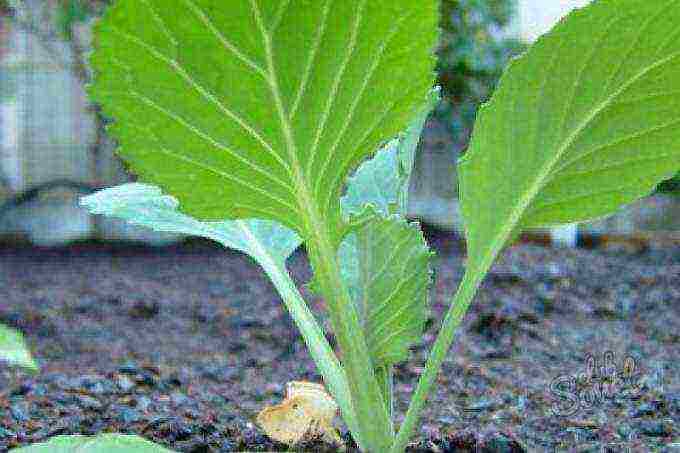
Plant the cabbage in the garden in late April or early May, when 4-5 true leaves have already grown on it. Initially, ornamental cabbage does not look very interesting - the peak of its beauty comes in early autumn. So that at first the beds do not look empty, cabbage can be planted in separate large flowerpots with a volume of 10-15 liters. At the same time, it is recommended to plant three plants for this volume. Until a luxurious bloom appears, the pot can be set aside, and then moved to a prominent place in the fall. Or to plant cabbage not in a flower bed, but in another place, but closer to autumn to make a transshipment with a lump of earth. So that the roots are not damaged during transplantation, the cabbage must be well poured with water a day before digging up.
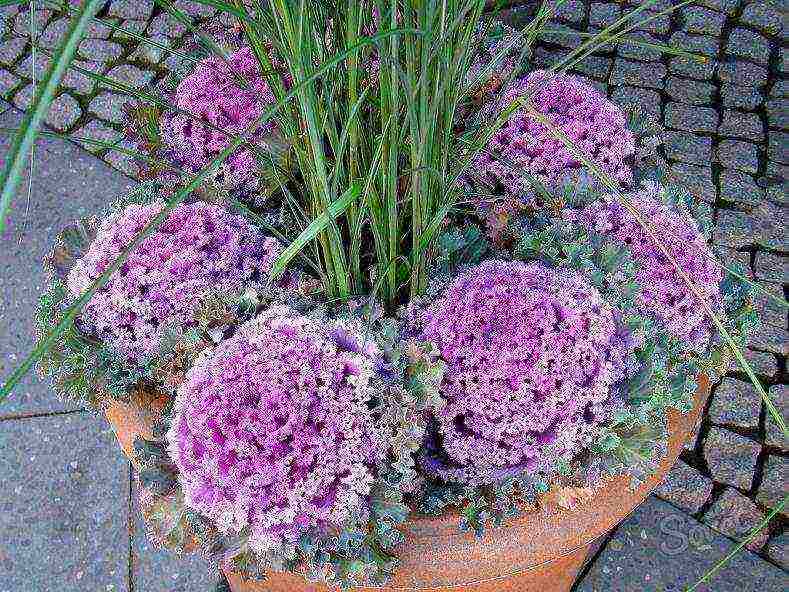
Water the ornamental cabbage and loosen the soil underneath regularly throughout the summer. If you plant the bushes in pots, then every two weeks feed the cabbage with any complex fertilizer for vegetables or flowers. When frosts begin in the fall, the cabbage in pots can be transferred to a closed, cool veranda. If the cabbage grows in the garden, then it is also possible to transplant it into pots and bring it into the house. Cabbage will not lose its decorative effect until the New Year, but under normal conditions: cool air and moist soil.
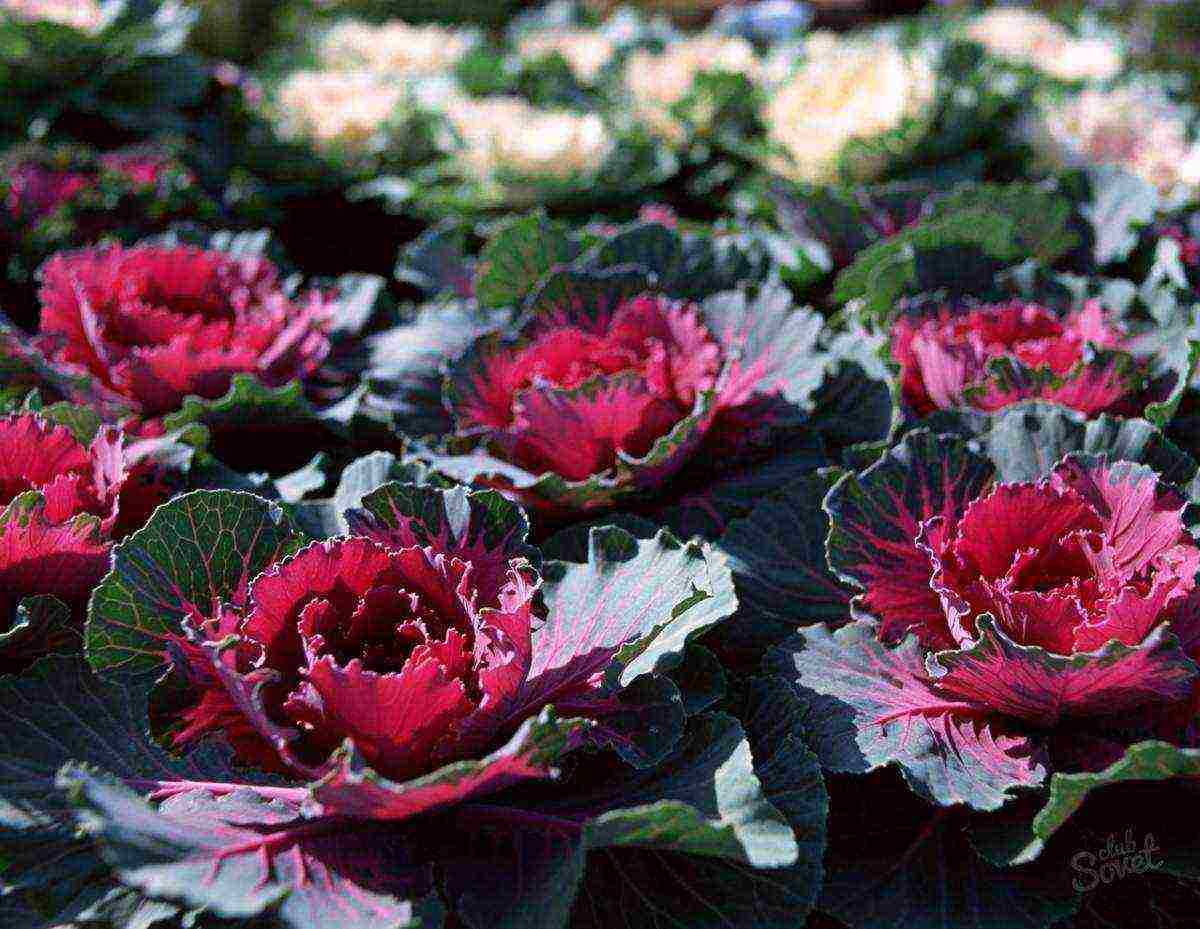
After the cabbage begins to wilt, put it in your cellar or basement. In the spring, plant the bushes in open ground again, and then in the second year the cabbage will bloom. You can collect seeds from it to grow seedlings again in the spring.
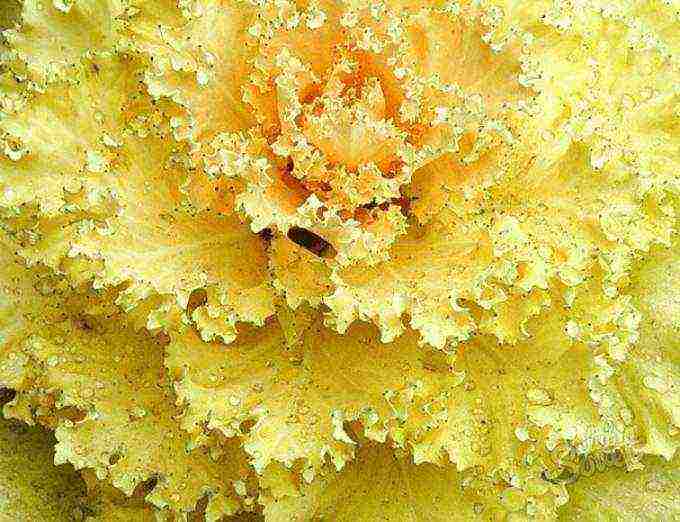
Ornamental cabbage got its name because of its unusual, openwork-looking leaves, and because of the variety of its color. It is pink, yellow, green, purple, cream, with colored spots and stripes. Choose a variety of cabbage and grow this beautiful and unpretentious plant in your area.
What to sow in a garden or flower bed to please both eyes and stomach? Ornamental cabbage is probably the first thing that comes to mind. Elegant, bright, with openwork leaves of various colors.
It will delight the eye until the first snow, and if you move it into the house in advance (along with a small lump of earth in a pot or cut in a vase), then until the New Year holidays.
Varieties and hybrids for every taste and color
There are varieties of ornamental cabbage, which reaches one and a half meters and resembles mini-palm trees. Along with them are completely different plants of undersized varieties, forming a lush rosette of colorful leaves. In group plantings, they resemble huge roses scattered on the ground. As a rule, the central part of such plants is colored not green, but in pale cream, violet or purple. Moreover, with moderate frosts (down to –8 ° C), the colors only become richer. Low-growing varieties of ornamental cabbage are very fond of Japanese breeders. They bred most hybrids with smooth, corrugated, fringed, or feathery leaves.
The cabbage variety Nimble Turtle with domed heads looks original, outwardly similar to the shell of a cartoon turtle or to light green corals of an intricate shape.
Our material The best varieties of ornamental cabbage (photos and descriptions) will help you decide on the choice of "cabbage" decoration for the site.
Sowing ornamental cabbage for seedlings
In general, ornamental cabbage is unpretentious, and its agricultural technology is quite simple. But in the zone of risky farming, it is necessary to grow cabbage from seeds exclusively using seedlings. Planting ornamental cabbage directly into open ground is too adventurous.
Seeds do not need to be soaked before planting. However, etching in a weak 1% solution of potassium permanganate will be useful. The pelleted seeds do not require any pre-treatment at all.
How to plant ornamental cabbage? Suitable soil for growing seedlings is turf and river sand mixed in equal proportions. Like any cabbage, its decorative "relative" also does not like sour soil. Therefore, ash can also be added to the ground or a universal soil can be used.
It is recommended to sow ornamental cabbage for seedlings in March or early April, deepening the seeds by 1 cm. The soil must be properly moistened before sowing. cabbage seeds require a lot of moisture to germinate. But in the future, watering should be moderate - as the soil dries out, so as not to provoke the development of fungal and viral diseases.
Tips for growing seedlings
When seedlings appear (usually the seeds begin to hatch after five days), the containers with the crops must be transferred to a well-lit, but cool room (12-15 ° C), otherwise the seedlings may stretch excessively.
The pick must be done after the appearance of two real leaves. In order not to injure the root system and once again expose the plant to stress, you can sow seeds not in seedling boxes, but immediately in peat pots or separate cups.
When picking, young plants are buried in the ground up to the cotyledon leaves and as they grow, they add earth. Experienced gardeners plant plants in a small hole, which is gradually filled with soil.
Young plants require a lot of light (12-15 hours a day). In order for them to develop well, at the initial stage they need to be supplemented with special phytolamps.
Planting ornamental cabbage in open ground
Planting ornamental cabbage in open ground is undesirable as long as there is a risk of recurrent spring frosts. Although ornamental cabbage can decorate your area before the first snow and frost, young plants are quite vulnerable. Usually, transplanting into soil or containers takes place in May.
It is better to choose a sunny area with loamy or sandy loam as a place of permanent "registration". In other conditions, ornamental cabbage will also take root well, but it will not look so impressive.
Handfuls of humus and wood ash are placed in the planting holes. You can add any mineral fertilizer for cruciferous plants - according to the instructions. To protect plants from cabbage flies, cruciferous fleas and excessive sun exposure, some gardeners cover each seedling with half a plastic bottle, thus creating a mini greenhouse. You can also use arcs and covering material or film.
Ornamental cabbage acquires an interesting shape and bright color as it grows - closer to autumn. If you plant such cabbage next to bulbs that do not require digging after flowering (for example, with certain varieties of tulips), then your flower bed will be elegant all season.
Ornamental cabbage - growing and care
Ornamental cabbage needs weeding, loosening of the soil and hilling (2-3 times per season), which contributes to the formation of lateral roots and the retention of moisture in the soil. In order for the elegant plant head to remain stable, experienced gardeners often sprinkle the cabbage with earth, leaving a small depression under the leaves (they are planted in a hole), and as they grow, they add fertile soil.
From June until the end of the growing season, ornamental cabbage can be fed with complex fertilizers (according to the instructions) or mullein infusion.
If the land on which you grow ornamental cabbage was fertilized with manure, the leaves of the plant will be larger, but in many ways they will lose their decorative effect, because the predominant color will be green.
Excessive application of nitrogen fertilizers reduces the resistance of seedlings to various diseases. At the same time, a balanced complex feeding (10 g of ammonium nitrate, 20 g of superphosphate and 10 g of potassium chloride per 10 liters of water), on the contrary, will help your plants resist blackleg and other diseases to which cabbage is prone.
Ornamental cabbage feels good and looks impressive in 10-15 L pots
Diseases and pests of ornamental cabbage
If you notice that your ornamental cabbage is already affected by root rot or black leg, it is better to remove the diseased plants, and spray the rest with the universal biofungicide Fitosporin (according to the instructions).
In order to prevent diseases, it is important to regularly huddle. You can add river sand or wood ash to the base of the plant and fight weeds in a timely manner. This is especially true for those plants that have common pathogens with ornamental cabbage (shepherd's purse, rape, wild radish, etc.).
Like any cabbage, slugs can also take a fancy to decorative ones. To combat them, there are special insecticides (Slug-Eater, Meta, Thunderstorm). To some extent, loosening and mulching the soil using coniferous needles helps.
Cruciferous flea beetles will be scared away by dusting with ash and tobacco dust in a 1: 1 ratio.In the case of an active attack by caterpillars or aphids, ornamental cabbage can be processed by the Commander or Aktara.
To repel insects, dill, basil, calendula or marigolds can be planted next to ornamental cabbage.
Ornamental cabbage of most varieties can decorate not only a flower bed, but also your table. There are varieties of cabbage, the leaves of which are bitter and unsuitable for food. But, fortunately, in nature everything is balanced, and along with vegetables that cannot be eaten, there are flowers that are completely edible.
Ornamental cabbage was very popular in ancient Greece, where it was appreciated not only for its spectacular appearance, but also for its beneficial properties.
The modern forms of this plant, the color of the leaves of which casts all shades of green and pink, serve as an excellent decoration for gardens, flower beds, greenhouses.
Ornamental cabbage. Photo. Description
Ornamental cabbage is nothing more than a collective name that combines several foliage forms of cabbage (Brassica oleracea). These are very beautiful biennial plants, the height of which ranges from 20-130 cm and up to 1 m in diameter. In the first year of the growing season, they form spectacular leaves, and in the second, they bloom and bear fruit.
For decorative plantings, plants of the first year are used and only those varieties that form large rosettes on a low, strong stem. They are characterized by long, wide leaves of an elliptical, ovoid or obovate shape, with curly edges, which gives the plant a lush, delicate appearance.
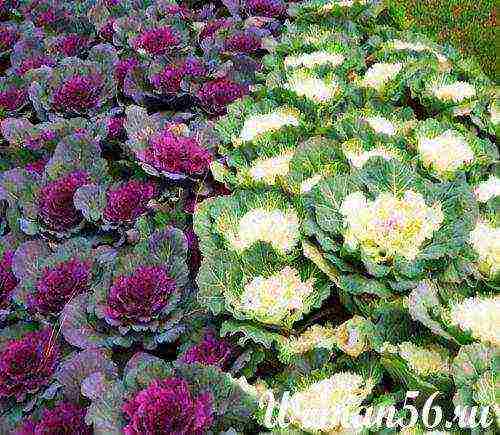
Ornamental cabbage - photo. Depending on the variety, the color of the leaves varies from snow-white to dark purple.
The color of the leaves is presented in the richest palette: various shades of green, green with a white stripe, gray-green, bluish-green with lilac or pink spot, white, yellow, cream, pink, deep purple. Moreover, the maximum brightness of the color is achieved only in autumn, with the onset of the first frosts.
This is the main advantage of ornamental cabbage: in the fall, when the leaves begin to fall and the colors around them fade and fade, this spectacular plant stands out brightly in the flower beds, which is not at all afraid of the cold. Moreover, it looks much more colorful at temperatures below freezing.
The dominant shades of this plant are purple and gray-green, and therefore it will look especially harmonious in a composition with flowers of rich orange or yellow colors. In late summer - early autumn, an alpine slide with your own hands will look very colorful, on the flower beds of which ornamental cabbage grows together in the company of original fezalis inflorescences or elegant marigolds.

Decorative cabbage. Growing from seeds
Preparing the landing site
The land for planting cabbage should be prepared at the very beginning of the season: add compost (10-15 liters per 1 sq. M) and deoxidizing materials, if necessary. This ornamental plant reacts very well to ash, dolomite flour containing a large amount of magnesium and calcium, as well as other fertilizers with magnesium and boron in the composition. It is also recommended to apply long-acting organo-mineral fertilizer during planting. Otherwise, then you will need to make weekly nitrogen fertilizing.
Ornamental cabbage, the cultivation of which usually occurs by sowing seedlings in containers, has medium-sized seeds (about 350 pieces per 1 g). That is, to obtain 100 plants, you need only 0.5 g of seeds.
Dishes and substrate for seedlings
Cabbage is planted in late March - early April, best of all in separate containers, the diameter of which should not be very large - about 3-4 cm.They are filled with a mixture of leafy soil, peat and sand in a ratio of 2: 2: 1. Then, for disinfection, it is poured with a hot, weak solution of potassium permanganate. When the substrate in the containers has cooled down, two seeds should be placed at a depth of 1 cm and covered with earth on top.
The pots are covered with plastic wrap and placed in a warm place until the first shoots appear. At a temperature of 18-20 degrees, they appear after a few days.
Temperature regime
If the air in the room is cooler, then the sprouts will sprout a little later. So that young plants do not stretch too much, immediately after the appearance of the cotyledonous leaves, the container with seedlings should be placed in a cooler, but at the same time well-lit place. The optimum temperature during this period will be 12-16 degrees Celsius.

This ornamental plant tolerates a drop in temperature very well, and is able to grow without harm to itself even with the first autumn frosts.
Fighting the "black leg"
The main scourge of seedlings are fungal diseases, in particular - the so-called "black leg". Prevention of this disease is the correct watering of the plants, which should be carried out before and immediately after sowing. Further, the seedlings do not need to be watered; sometimes it is enough to gently spray them. And only when the soil dries up significantly, and the sprouts are properly strengthened, they can be watered.
Another method of preventing the "black leg" is to powder the soil with sifted wood ash.
Picking seedlings and caring for it
With the appearance of the second or third true leaf, young plants must be dived either into larger pots, or already on a seedling bed, every 10-15 cm.
Caring for ornamental cabbage seedlings is quite simple: it is necessary to water and fertilize it in a timely manner (nitroammofoska is introduced when the second true leaf appears, and the wagon-kemiru - a couple of weeks before the seedlings are planted in open ground).

Ornamental cabbage - photo.
At an optimal temperature (17-20 degrees), a sufficient amount of moisture and light, cabbage grows very quickly. Considering that this ornamental plant tolerates a drop in temperature well, in May you can safely plant seedlings in open ground (at 15-20 degrees Celsius during the day, and 10-16 degrees at night).
It is best to plant young cabbage in a small greenhouse covered with a covering non-woven material (lutrasil or spunbond). The distance between the planted plants should be at least 50-60 cm.
Ornamental cabbage tolerates transplanting well, and during one season it can be transplanted up to three times, while trying to dig up a head of cabbage with a large clod of earth and water abundantly.
Planting cabbage in open ground
Also, seedlings can be grown immediately in the open field. At the same time, it grows stronger and harder than seedlings grown at home.
Seeds begin to sow immediately after the snow melts, somewhere in the middle of April. Sowing is done under arcs with non-woven material or plastic wrap, the temperature in the greenhouses should be about 18-20 degrees. Each seed is planted to a depth of 1-1.5 cm, at a distance of 5-6 cm from each other.
In May, already matured seedlings can be transplanted to a permanent place.

Please note that ornamental cabbage reaches its maximum flowering only with the onset of autumn. For this reason, it is recommended to postpone planting plants as a decoration for a flower bed for a sufficiently long period.
Before this time, it can grow imperceptibly in the vegetable garden. If you want to enjoy early and abundant flowering, you need to know the nuances of how to grow petunia seedlings.
Ornamental cabbage. Care features
The soil
Ornamental cabbage grows well in any soil, although it is preferable for it loamy or suspended soil, as well as soil enriched with humus.
Top dressing
Plants need to be fertilized with nitrogen and organic fertilizers, which can accelerate their growth and development. If the soil is nutritious enough, 2-3 additional fertilizing is enough at intervals of 7-10 days. On poor soils, cabbage should be fertilized more often, about 4-5 times.

You should not use manure as fertilizer, as it promotes the growth of huge leaves, which will be painted mainly green.
Watering
Watering should be regular and abundant enough, since ornamental cabbage is a moisture-loving plant. You need to be especially careful in hot weather, making sure that the ground does not dry out too much.
Growing cabbage in pots
If desired, ornamental cabbage can be grown in flowerpots or large pots, the capacity of which should be at least 10-15 liters. No more than three plants can be planted in such a container.
The advantage of such a planting is the possibility of rearranging the container, which allows you to admire the beautiful cabbage at the entrance to the house, on the balcony, on the flower bed.
In this case, the plants should be watered once every two days, and with the onset of hot weather - daily.
Pest control
The main enemies of ornamental cabbage are slugs and caterpillars of the whitebird butterfly. To protect plants from slugs, the ground must be carefully sprinkled with fallen needles or ash.
To protect against caterpillars, it is recommended to use a superphosphate solution (stir 100 g in 10 liters of water), which should be sprayed on the plants after watering or rain.
Views: 29573
Do you want to find an original and undemanding garden decoration that can please the eye even in late autumn? Then hurry up to get acquainted with ornamental cabbage and for sure you want to grow its lush rosettes with your own hands.
What is ornamental cabbage?
In essence, ornamental cauliflower is the collective name for several varieties of collard greens. This is a biennial plant that develops a leaf rosette in the first year of vegetation, and blooms and bears fruit in the second year. Plants of the first year are used to decorate the site.
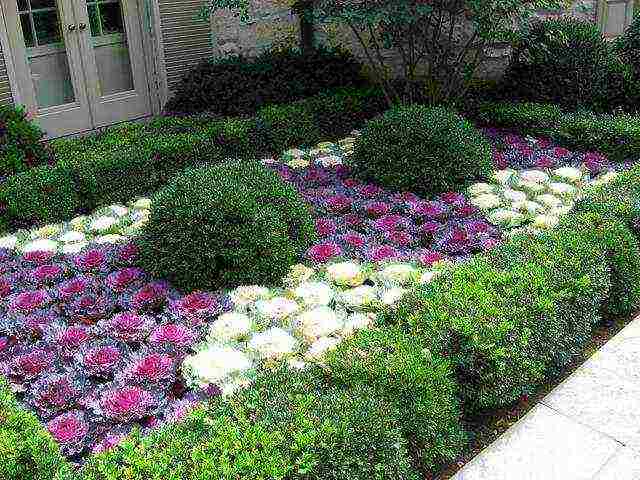
Depending on the variety, the decorative cabbage flower in height can reach from 20 to 130 cm, and in diameter - up to 1 m. The leaves of the plant, which can have different shapes and colors of leaves, are especially decorative. The leaf size in different cultivar groups varies from 20 to 60 cm in length and from 10 to 30 cm in width. Perennial ornamental cabbage surprises with a variety of forms of the leaf plate, which can be ovoid and obovate, elliptical and truncated-elliptical. The edges of the leaf are jagged and strongly dissected. The color of the rosette is also surprising, in which white, pink, lilac, cream are combined with light green or bluish green.
Practically all varieties of ornamental cabbage are photophilous, but they can grow in partial shade, however, in sunny areas, the heads of cabbage will turn out to be larger, and the color will be brighter.
How to grow ornamental cabbage:
soil preparation
The agricultural technology of ornamental cabbage practically does not differ from the technology of growing the familiar white cabbage. When planning to grow this plant, it should be remembered that it grows best on loamy and sandy loam soils. To obtain a good harvest and achieve a high decorative effect of the plant, it is better to prepare the site for growing it in the fall. In particular, fertilization is recommended at this time. For 1 sq. make compost (3-4 kg), ammonium sulfate (20 g), potassium chloride (15 g), superphosphate (42 g). All fertilizers are carefully embedded in the soil. If the level of acidity of the soil is increased, then it can be reduced with the help of lime.
In the spring, before planting ornamental cabbage, the soil on the site is loosened and leveled again. When choosing a site for cultivation, it should be remembered that cabbage grows well in those places where tomatoes, potatoes, onions, legumes, cucumbers and root vegetables grew before it.
Planting ornamental cabbage It is worth noting that ornamental cabbage, planting and caring for which, by the way, does not differ in particular difficulties, is traditionally grown from seeds in a seedling way.In this case, seedlings are sown both in containers or greenhouses, and immediately in open ground.
1. Sowing ornamental cabbage in pots.
The cultivation of ornamental cabbage from seeds begins in late March and early April, when 2 seeds are sown in small pots with a diameter of about 3-4 cm and they are embedded in the soil to a depth of about 1 cm. Before sowing, it is advisable to treat the soil with a fungicide in order to further avoid damage to young plants with a "black leg".
If you keep crops at a temperature of 18-20 degrees, then after 2-5 days the first shoots will sprout. Caring for such seedlings is simple. As soon as a friendly growth appears, the seedlings are transferred to a cooler room. Caring for ornamental cabbage seedlings is simple. It is enough to periodically water young plants moderately. With the appearance of the second true leaf and approximately 14 days before planting in open ground, the seedlings are fed, using, for example, Kemiru Universal or nitroammofoska per 1 square meter. 1 tablespoon of fertilizer.
In late April - early May, pre-hardened seedlings are planted in open ground. At this point, each plant should have 4-5 leaves. By the way, it is not necessary to plant ornamental cabbage right away in a permanent place. Since the peak of its decorative effect occurs in autumn, it can be grown for a long time in the garden, and by autumn it can be transplanted into a flower bed.
2. Sowing ornamental cabbage in the greenhouse.
For sowing seedlings in a greenhouse, as well as containers, a soil mixture consisting of sand, peat and garden soil is prepared at a rate of 2: 1: 2. It is important that the harvested soil layer reaches about 10-15 cm. Before sowing, the soil is treated with a solution of potassium permanganate or fungicide for disinfection and prevention of fungal diseases of seedlings.
Seeds are laid out in 2 pieces in small dimples about 1 cm deep and covered with earth. To speed up germination, the crops are covered with foil. At this stage, the temperature in the greenhouse should be around 20 degrees. With the emergence of seedlings, the temperature is reduced to 12 degrees. Seedlings provide moderate watering and periodically loosen the soil. Young shoots of ornamental cabbage can be planted in open ground as soon as the second leaf appears.
3. Sowing ornamental cabbage in open ground.
As practice shows, ornamental cabbage, planting and caring for which is initially carried out in open ground, is more hardened and resistant to negative environmental influences. Sowing ornamental cabbage in open ground begins from the beginning of April (if the weather and climatic conditions of the region allow), providing crops for the first time with a film cover.
Seeds are sown in loose soil according to the 5 by 5 cm scheme, seeding to a depth of 1.5 cm. When shoots appear, the crops are thinned out, leaving stronger plants. In the future, as necessary, the seedlings are watered, weeds are removed and the soil is loosened. Seedlings are transplanted to a permanent place after 30-45 days, arranging plants according to the scheme 70 by 70 cm.
In the future, in order to get large lace rosettes of ornamental cabbage, it is necessary to provide it with timely care.
How to grow ornamental cabbage: care features

Such an unusual ornamental cabbage, the cultivation and care of which sometimes surprises with its simplicity, like other garden dwellers, requires a little attention.
The main methods of caring for ornamental cabbage are periodic loosening of the soil with simultaneous removal of weeds and regular abundant watering, the frequency of which is determined based on the characteristics of the soil and weather conditions. When growing ornamental cabbage in containers with a volume of 10-15 liters, watering is carried out every three days, and in the heat and daily. As it grows, this type of cabbage forms a rather powerful and voluminous rosette, therefore the plant must be periodically spud in order to stimulate the appearance of additional roots and increase its resistance.
In addition, due to its unpretentiousness, ornamental cabbage easily transfers from place to place. During the season, the plant, along with an earthen lump, can be transplanted 2-3 times. To quickly take root in a new place, it is recommended to feed cabbage with a 1.5% fertilizer solution, for example, "Kemira-Lux".
If the soil was properly filled before planting, then additional fertilizing during the season will not be needed. But if it was not possible to prepare the soil in advance, then you can also feed the ornamental cabbage in the ground. 10-14 days after transplanting to a permanent place, the plants are fertilized with urea or mullein solution, which is diluted at the rate of 1 liter can for 1 bucket of water. Such fertilization will promote more active leaf growth. The next stage of feeding is carried out 14 days after the first. This time, complex mineral fertilizers are used with the same dosage that is used for planting.
Diseases and pests of ornamental cabbage

Like most garden plants, decorative cabbage can be affected by cruciferous flea beetles, slugs and caterpillars. Such pests are especially dangerous for young immature plants. Often to combat them, it is recommended to use natural folk remedies. For example, for the destruction and prevention of a flea plants are powdered with tobacco, red pepper, ash or a mixture of these three. In this case, the treatment is best done after watering, so that the mixture better clings to wet leaves. With a small number of pests, a flea can be washed off from cabbage leaves during irrigation and sprinkling.
You can protect cabbage from slugs with ash or needles.sprinkled on the soil, and the plants themselves. Same for prevention damage to ornamental cabbage with various pests next to plants marigolds, basil, dill or calendula are planted.
If cabbage is grown purely for decorative purposes and it is not planned to eat it, the leaves can be treated with more effective pesticides or insecticides.
To avoid root diseases affecting cabbage, in particular, phomosis or keel, it is important to carry out regular crop rotation, maintain the acid balance of the soil and periodically use microbiological preparations.
How to collect ornamental cabbage seeds?
Ornamental cabbage, traditionally seed-propagated, is a biennial plant. AND the seeds ripen just on the second year plants. In autumn, the plants are dug up together with an earthen lump, the lower leaves are cut off and added to the sand until spring. The transplanted rosettes of ornamental cabbage are stored in a dry, well-ventilated room in winter, making sure that their roots do not dry out. With the onset of spring, as soon as weather conditions permit, ornamental cabbage, which was previously grown and cared for in closed ground, is again planted in the garden. For pollination to be more effective, it is necessary to plant several plants nearby.
The flowering of biennial ornamental cabbage begins in June-July. Gradually, pods form in place of inflorescences, in which seeds ripen by autumn. Since birds are very fond of them, it is advised to cover the pods with a thin cloth throughout the summer. When the pods are somewhat dry and yellow, they are cut and tied into a bunch. The bundle itself is hung in a dry place by sending a newspaper underneath. After a couple of weeks, the pods will completely dry out and will peel well.
When planning to collect seeds from ornamental cabbage, the main thing to remember is that selected varietal plants are left for their ripening. If one of the hybrids of this plant flaunts on your flower bed, then you will not be able to collect seeds from it and you will have to buy seed in the store for growing in the following years.
Ornamental cabbage varieties and their uses
Today, ornamental cabbage in a flower bed is not such a frequent visitor, although in autumn it will give odds to any flowering plant. In addition, the unpretentiousness of the day type allows it to be transplanted to flower beds as early as August, when the plant gradually acquires an increasingly bizarre appearance and color every day.
Like other varieties of cabbage, ornamental cabbage can be eaten. True, its leaves have a slightly bitter taste, which can be gotten rid of by freezing the leaves before preparing food from them. But since, in terms of taste, we traditionally taste more white cabbage, it is better to use decorative varieties to decorate the autumn garden with exotic forms and colors.
The people traditionally divide the varieties of ornamental cabbage into two groups.1. Japanese "roses"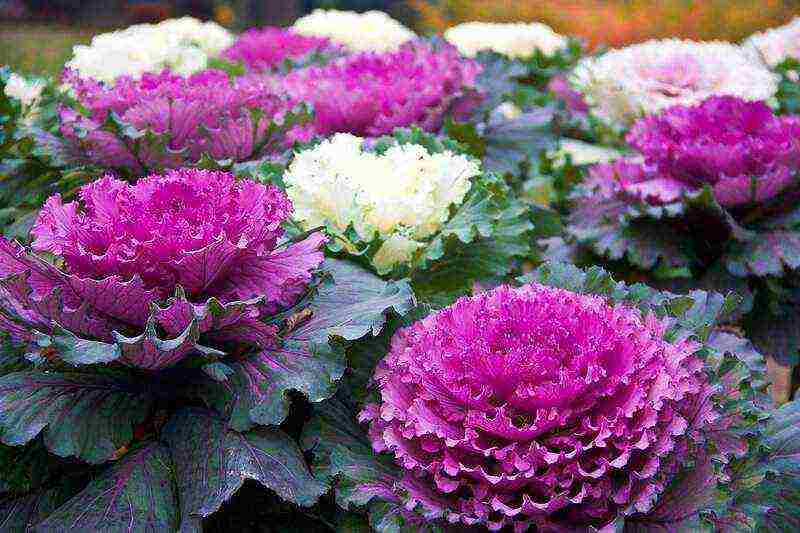
All varieties easily tolerate a change of growing place and short-term night frosts down to -12 degrees.
In landscape design, such varieties used to decorate ridges, borders, parterres and flower beds. It is convenient to plant grown ornamental cabbage in place of faded spring bulbous and earlier annuals. Large rosettes allow you to use significantly fewer plants to decorate one flower garden in comparison with traditional annuals.
Popular varieties:
• decorative cabbage "Tokyo" - is distinguished by a bright middle of white, pink or reddish color, contrasting against the background of dark green leaves. The leaf blade of this variety series is rounded with a slightly corrugated or wavy edge, and the size of the plant itself rarely exceeds 35 cm;
• ornamental cabbage Osaka - very similar to the previous variety series, but has larger rosettes, which reach 45 cm in diameter and up to 60 cm in height. The edge of the leaf can be either almost flat or densely double;
• decorative cabbage "Nagoya", the main distinguishing feature of which can serve as a dense multilayer fringe along the edge of the leaves. Dense rosette up to 60 cm in size;
• ornamental cabbage Sunrise - a hybrid, the rosette of which resembles a blossoming rose of a gentle cream shade;
• decorative cabbage "Peacock tail" - a variety with carved foliage not exceeding 30 cm in height, the color of the leaves is often green with a white center or purple with a raspberry center;
• decorative cabbage "Spoonbill" - one of the most spectacular hybrid varieties with a pink color of leaves and a rosette in the shape of a rose flower. It reaches a height of about 45 cm.
2. Palm-like varieties of ornamental cabbage

In landscape design, such plants are often placed on the back of the mixborder. When planting in annual flower beds, they are given a central place with planting three plants together or singly.
Popular varieties:
• "Lark's Tongue" - a variety of ornamental cabbage, which is characterized by densely corrugated green leaves cut along the edge, reaching about 70 cm in length with a total plant height of about 120 cm;
• decorative high red cabbage - the variety is very similar to the previous one, but has purple leaves up to 60 cm in length;
• variety series "Calais" - Plants with corrugated lyre-like leaves of bluish, red and green shades, often not exceeding 70 cm in height;
• decorative cabbage "Kai and Gerda" - the hybrid of the first generation surprises with mixed purple and green leaves with a total height of 50-80 cm.
Fancy rosette shapes and a variety of ornamental cabbage varieties make it easy to get a real decoration for an autumn garden.
published

